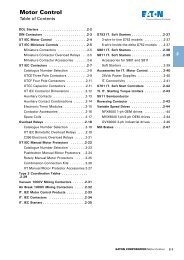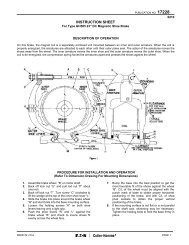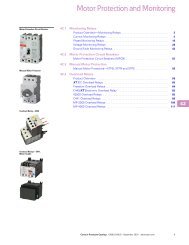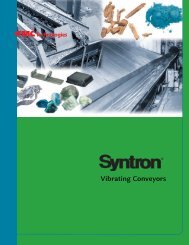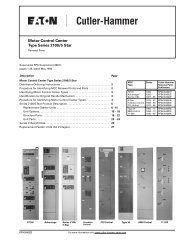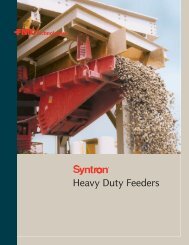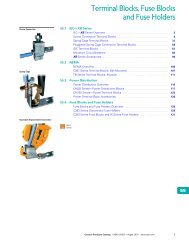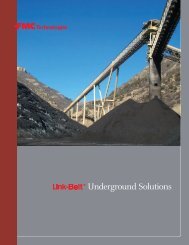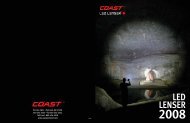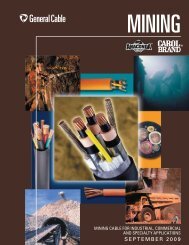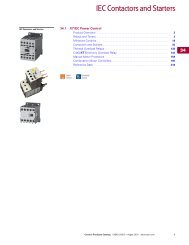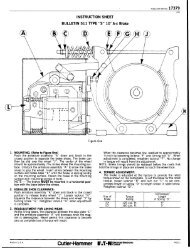Syntron® Vibrators - FMC Technologies
Syntron® Vibrators - FMC Technologies
Syntron® Vibrators - FMC Technologies
You also want an ePaper? Increase the reach of your titles
YUMPU automatically turns print PDFs into web optimized ePapers that Google loves.
Pneumatic <strong>Vibrators</strong><br />
Selecting the Proper Syntron ® Pneumatic Turbine Vibrator<br />
Bins or Hoppers<br />
In order to move material in a bin or hopper, the friction<br />
between the material and the bin wall must be broken. Once<br />
the friction is broken, material cannot cling to the sides of the<br />
bin and it will flow out through the discharge. For 80 percent<br />
of all turbine bin vibrator applications, the vibrator force<br />
needed to accomplish this is simply calculated as follows:<br />
■ Calculate the weight of the material in the transition or<br />
sloping part of the bin. Normally, this is the only place<br />
where the friction between the material and the bin side<br />
has to be broken. Do not calculate the total weight, only<br />
what is in the transition part of the bin.<br />
■ For conical bins, calculate as follows:<br />
0.261 x dia. 2 x height x material density in lb/ft 3 (kg/m 3 )<br />
■ For rectangular bins, calculate as follows:<br />
Length x width x height x 1/3 x material density.a<br />
NOTE: For selecting the proper pneumatic piston vibrator model,<br />
see page 42.<br />
When the weight (lb) has been calculated, divide the<br />
weight by 10 to get the force or impact needed from the<br />
vibrator (lbf). If the weight is calculated in kg, divide the<br />
weight by 1.02 to get the force or impact needed from the<br />
vibrator (N). For example: The conical part of a 25-ton bin<br />
contains 7000 lb. Divide 7,000 by 10 to get the force (lbf)<br />
or impact needed from the vibrator. Find a suitable vibrator<br />
on pages 35, 36 and 38.<br />
Additional considerations when sizing vibrators to bins:<br />
■ If the bin side angle is less than 30 degrees, select a<br />
larger vibrator.<br />
■ If the bin has a vertical section, select a larger vibrator.<br />
■ If the bin wall is extra thick (see tables pages 35, 36 and<br />
38), select a larger vibrator.<br />
■ On very sticky and hard to move materials, it is better to<br />
use two small vibrators instead of one large one (size the<br />
two smaller ones by dividing<br />
the required force in half).<br />
Two Syntron ® model TB-320 Pneumatic<br />
Turbine <strong>Vibrators</strong> mounted on a batch<br />
hopper.<br />
Vibrating Tables for Packing Materials<br />
Dense materials respond best to high-frequency vibration<br />
while light, fluffy or flaky materials respond best to<br />
low-frequency vibration. For packing or settling materials,<br />
use a vibrator with an impact force of one-and-a-half to two<br />
times larger than the weight of the material plus container.<br />
Find a suitable vibrator on pages 36 and 38.<br />
Vibrating Screens<br />
For self-cleaning screens, use a vibrator with a centrifugal<br />
force (impact) four times the weight of the material plus<br />
the weight of the screen.<br />
NOTE: Coarse, lumpy, sticky or wet materials respond best to highfrequency<br />
vibration; powdery and dry materials respond best to lowfrequency<br />
vibration.<br />
Consolidating Concrete<br />
For three-inch "slump" concrete, use a vibrator with the<br />
same force (impact) as the weight of concrete and form. For<br />
one- to two-inch slump concrete, an additional 30 to 50 percent<br />
impact is needed. For dry mixes (zero slump), increase<br />
the impact by 100 to 200 percent.<br />
Chutes<br />
The force required of the vibrator is equal to the weight<br />
of the chute plus vibrator plus maximum material in the<br />
chute. See page 40 for more details.<br />
34



